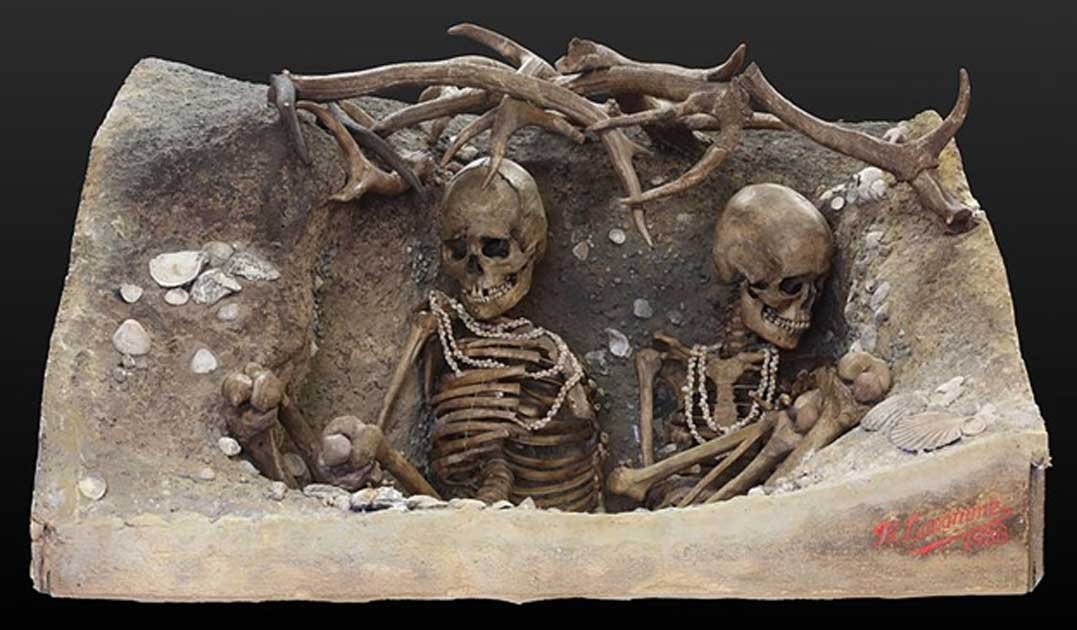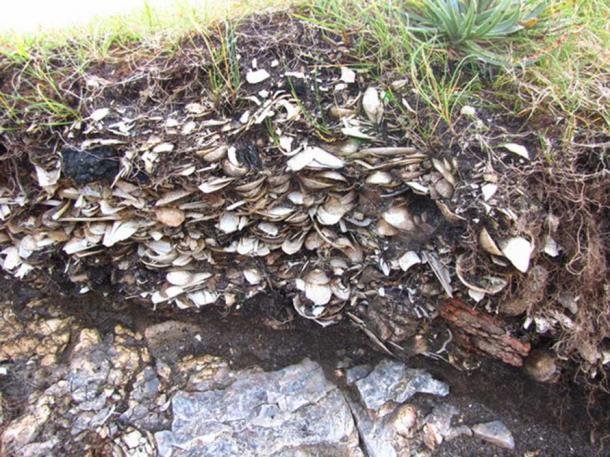
A Makeshift Casket of Sea Shells and Antlers: The 6500-Year-Old Grave of the Unfortunate Ladies of Téviec.
Téviec would be a rather anonymous island located somewhere in Brittany, France, if it wasn’t for its great archaeological value thanks to the many finds – mainly from the Mesolithic Period – that have been excavated there. These finds include the skeletons of two women, dated between 6740 and 5680 BC, who may have been violently murdered.

Archaeologists Put Téviec on the Mesolithic Map
Téviec is one of the very few known Mesolithic sites in Brittany, along with Pointe de la Torche, Hoëdic and Beg er Vil on the Quibe. It has been the subject of a biotope protection scheme for the past 35 years. Therefore, landing on the island has become a troublesome task for contemporary archaeologists, since it is generally prohibited from 15 April to 31 August.

That wasn’t always the case, though. From 1928 to 1934, archaeologists Marthe and Saint-Just Péquart discovered and excavated a culturally and archaeologically rich Mesolithic site on the island, dated to between 5700 and 4500 BC. According to most historians, this is considered the end of the Mesolithic period in western France and it overlaps with the beginning of the Neolithic period.

The main finds at the site were substantial middens formed of oyster and clam shells and ten multiple graves containing 23 skeletons, including adults and children. Among the shells were the remains of animals as well, such as dogs, crabs, fish, lobsters, seabirds, deer, and boar among others. Due to the acidity of the soil in the location, the bones have been remarkably preserved, even though many of the skeletons showed clear signs of brutality and violence, including one with an arrowhead embedded in its spine.

The Unfortunate Ladies of Téviec
The most fascinating and mysterious of all discoveries, however, is undoubtedly the grave that includes the skeletons of two women aged 25–35, dubbed the “Ladies of Téviec.” Their bodies were buried delicately in a pit that was partly dug into the ground and coated over with debris from the midden. The corpses had been protected all these centuries by a roof made of antlers and supplied with pieces of flint, boar bones, and jewelry made of sea shells such as necklaces, bracelets, and ringlets for their legs. The grave collection was unearthed from the site as a whole and is now on display at the Muséum de Toulouse, where its restoration in 2010 earned several awards.

The thing that shocked archaeologists the most though, was the blatant violence and brutality the two women sustained before they died. Scientists examining the skeletons concluded that one of them had suffered five blows to the head, two of which were possibly fatal, and had also received at least one arrow sH๏τ between the eyes. The other body also had traces of injuries, but not as violent as the body of her “friend.” In recent years, however, this diagnosis is debated by some archaeologists, who claim that the immense weight of the soil above the grave may have been the cause of damage for the skeletons. An obvious question that probably occurs upon reading this is: How could the weight and composition of any soil – no matter how heavy it might be –ever justify an arrow sH๏τ between the eyes? It doesn’t make any sense, does it?
A Very Cold Case: Attempts to Solve the Téviec Mystery Almost 6,500 Years Later
In 2012, replicas of the two skeletons were laid for the first time on a mortuary slab of Toulouse Natural History Museum, during an exhibition тιтled Prehistory: The Investigation , which became a big hit in France.
“When you create an exhibition, you need to create an atmosphere and a lot of TV shows are about CSI and forensics and they always start with a forensics table – and here it is,” said Dr. Francis Duranthon, the director of the Toulouse Natural History Museum, pointing to the mortuary slab.
In the city of Toulouse alone, more than a hundred thousand people visited the exhibition, while in Paris two hundred thousand people watched closely the attempt of the scientists to solve this prehistoric mystery.
Isotope analysis of the two women’s teeth showed a diet of seafood and meat. That caused scientists to speculate that the two females possibly came from a small community that farmed, harvested the sea, and hunted. The exhibition also revealed that this was probably a community where women fulfilled a more domestic role. “It is unusual to find women killed this way during this period,” said Duranthon and added, “What we know is that at least two people were involved in these killings.”

According to several academics, raids in order to steal food were pretty common back then and they suggest that the two unlucky women could have been victims of a bloody raid. However, some historians claim that what possibly killed the women was a long series of unfortunate meteorological phenomena. Droughts back then would usually decimate a farming community, while an extreme hailstorm destroyed crops, and people would see these as signs that the gods needed to be appeased. Thus, the two women might have been sacrificed as victims of a ritual murder, slain by people they knew – or even family members.
So, what really happened to the “Ladies of Téviec”? As it’s the case with many historical mysteries throughout the centuries…We will probably never know!





